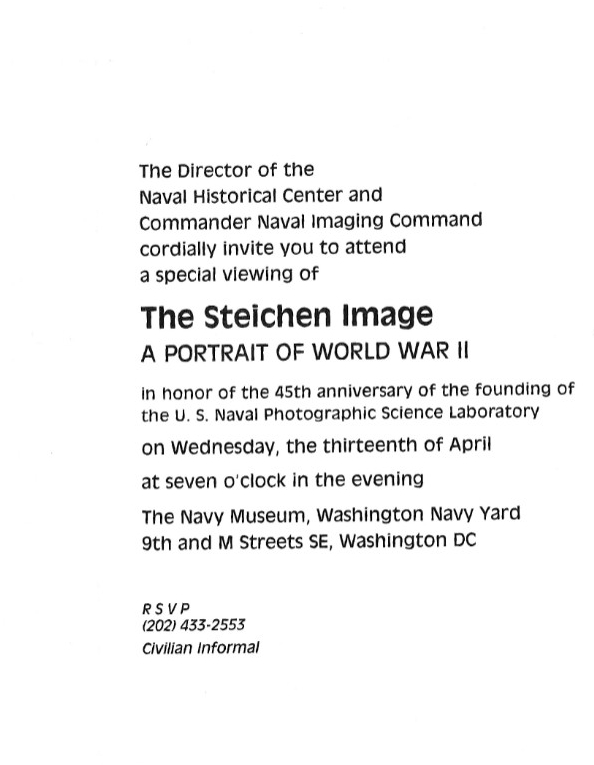The Steichen Image: A Portrait of World War II
The Navy Museum, now National Museum of the U.S. Navy, displayed the exhibit The Steichen Image: A Portrait of World War II from April to September 1988. This photographic exhibition featured black-and-white and rarely seen color prints from original negatives by Edward Steichen and the men who served in his photographic units.
The photographs represented Steichen’s endeavor to capture all aspects of the war effort and to ensure that the military and civilian experiences were told. In 1942, Steichen and his six hand-picked photographers began their assignment with the Naval Aviation Photographic Unit. By the end of the war, Steichen, as director of the newly formed Naval Photographic Institute, was responsible for 4,000 photographers─the Navy’s combat camera crews. They traveled on surface ships, submarines, and aircraft, and visited homefront factories to record the events of World War II.
The exhibit was divided into four sections: "America Goes to War," "Flattops at War," "Between the Battles," and "Advance Across the Pacific."
"American Goes to War" focused on the production scenes at home highlighting work on aircraft plant assembly lines and the training of the men and women who joined the Navy. "Flattops at War" portrayed activity on board aircraft carriers, from the feverish pace of launching planes to the aftermath of aerial battles. "Between the Battles" examined the tranquil times of rest, relaxation, and recreation. The last months of the war comprised the fourth section of the exhibition, "Advance across the Pacific."
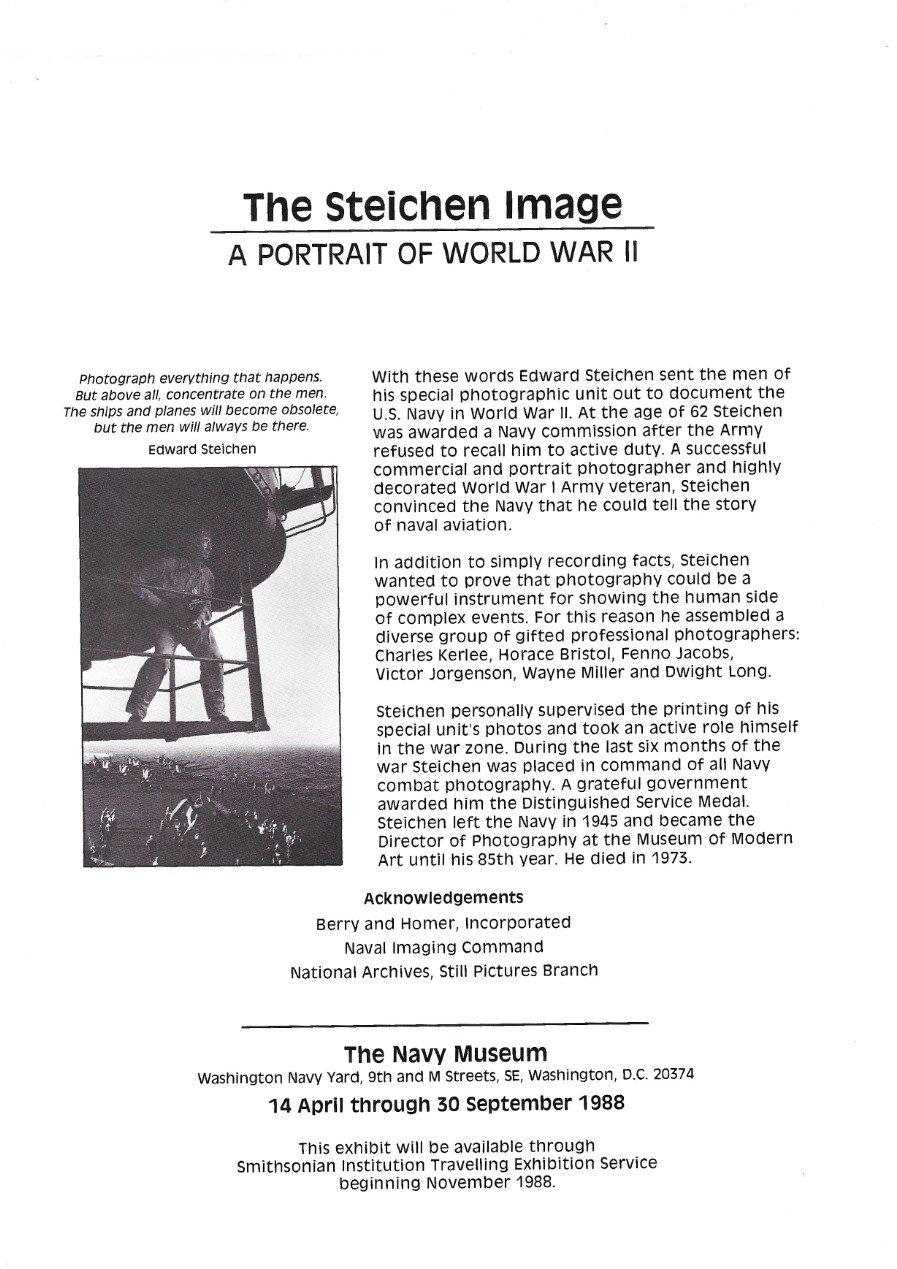
A Nation At War
The Home Front
Following the attack on Pearl Harbor, 16 million Americans enlisted in the armed forces. On the home front, more than 123 million civilians joined in the war effort. Women joined the assembly lines as riveters, welders, and factory workers – jobs previously thought of as men’s work.
From coast to coast, production went on around the clock. President Franklin D. Roosevelt asked the factories to complete 50,000 planes each year. The demand was not only met, but surpassed. More than 296,000 aircraft and 76,000 ships and vessels were produced during the war years.
Recording this phenomenal effort required special talents. Edward Steichen recruited Charles Fenno Jacobs, a respected professional photographer who had worked for Life and Fortune magazines before the war. Jacobs had a genuine curiosity about the people he photographed and an intuitive visual sense. His color photographs of factory workers are portraits of the nation at war.
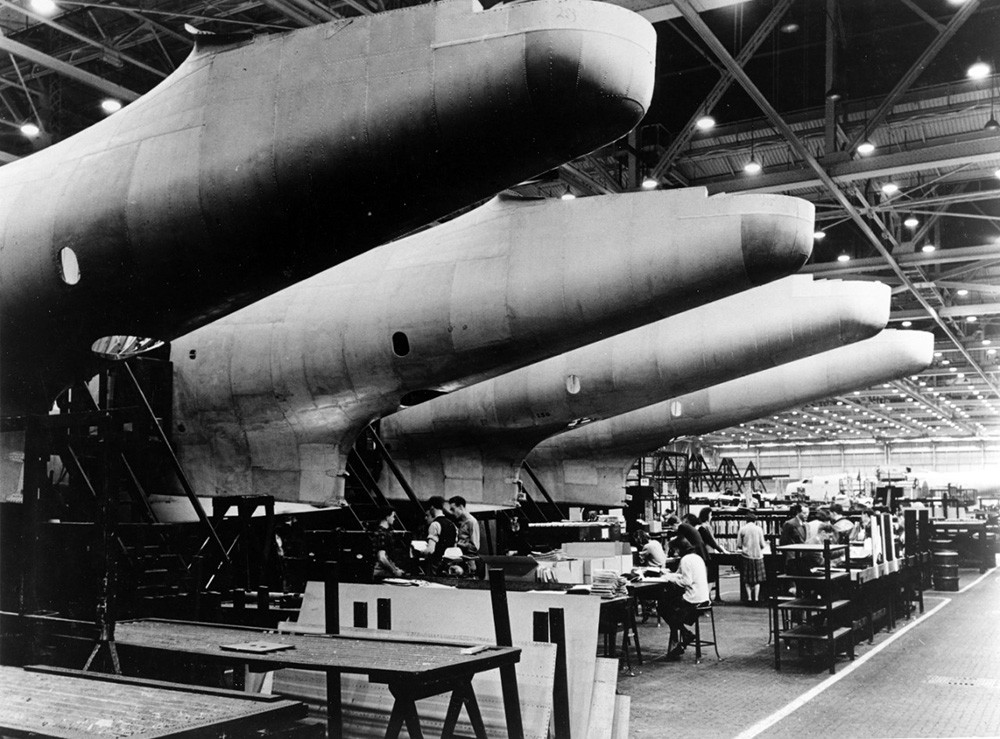
Glenn L. Martin Aircraft Factory, Baltimore, Maryland. Assembly of fuselages for PBM Mariner patrol bombers, February 1943. Photographed by Lieutenant Charles Fenno Jacobs, USNR. Official U.S. Navy photograph, now in the collections of the National Archives, 80-G-412735.
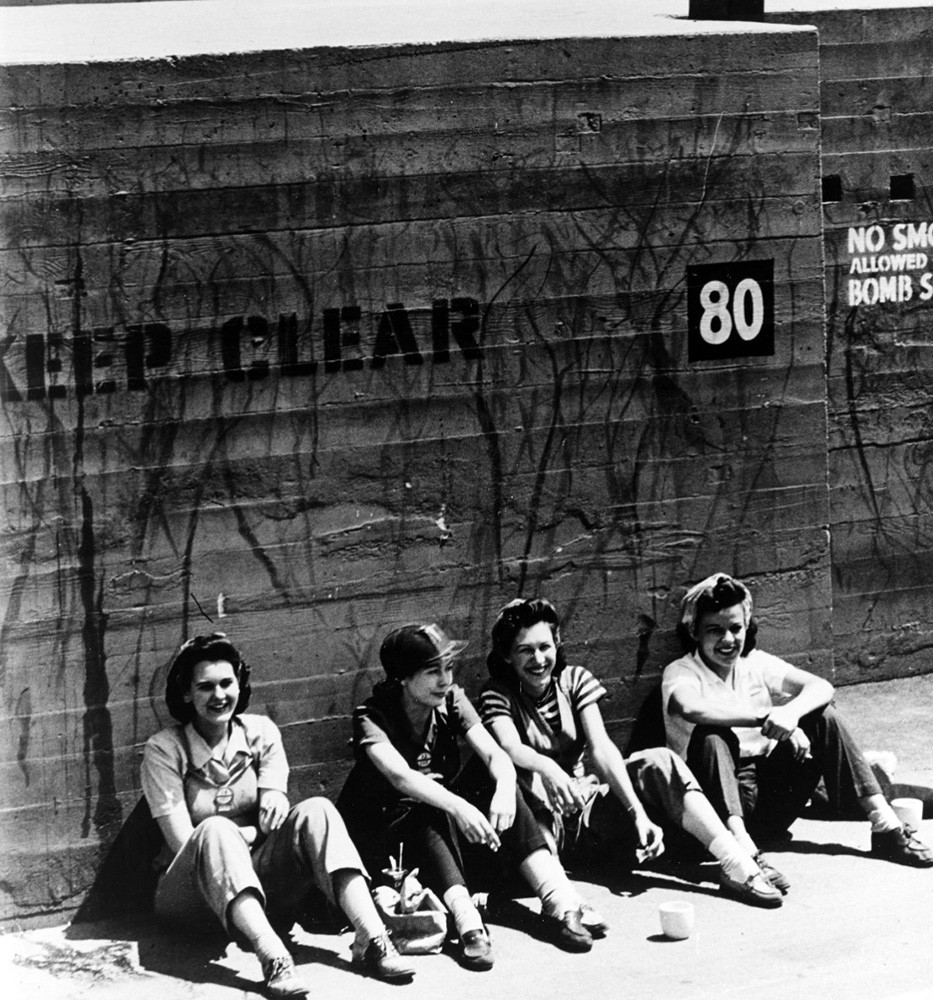
Vega (Lockheed) Aircraft Plant, Burbank, California. Four women workers sit against a bomb shelter wall during their lunchtime break, August 1943. Photographed by Lieutenant Charles Fenno Jacobs, USNR. Official U.S. Navy photograph, now in the collections of the National Archives, 80-G-412639.
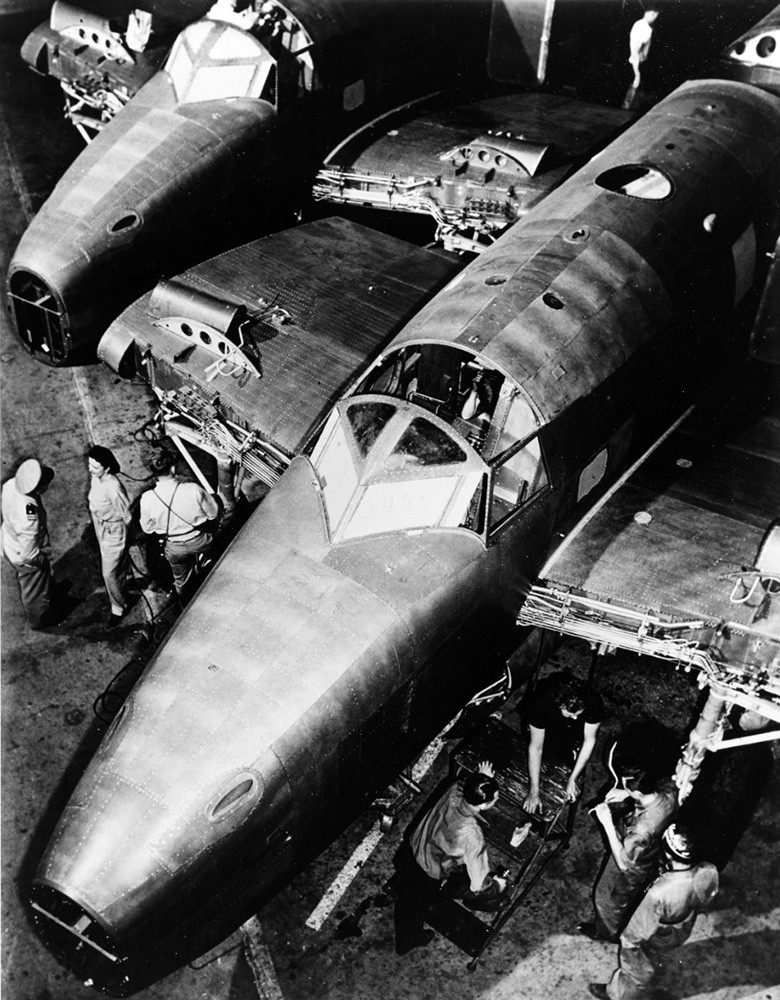
Vega (Lockheed) Aircraft Plant, Burbank, California. PV-1 Ventura patrol aircraft on the assembly line, August 1943. Photographed by Lieutenant Charles Fenno Jacobs, USNR. Official U.S. Navy photograph, now in the collections of the National Archives, 80-G-412639.
Aviation Training
Throughout 1942 and 1943, Edward Steichen’s special photographic unit operated out of the Navy’s Training Literature Division. Its mission was to produce photographs that would attract attention to the Navy’s air wings to help recruit pilots. The limited scope of this assignment did not deter Steichen. He understood the importance of these small, early assignments, taking an active personal role and insisting on high-quality, professional results.
In June of 1942, Steichen and three members of his new unit went to several naval air stations. Wayne Miller, the first official member of the group, was an enthusiastic young ensign who, upon learning of the Steichen unit, had immediately applied for duty. Charles Kerlee, a respected West Coast photographer, and Victor Jorgensen, a photojournalist from Portland, Oregon, were proven professionals. Steichen wanted men who required little training and could begin work right away.
Steichen insisted that a variety of professional talent could present a balanced viewpoint with images that were strikingly photographic yet understandably human. Ironically, the unit’s success contributed to its members’ chief complaint. The Navy prohibited individual photo credits, and despite all his efforts, Steichen was never able to have this rule relaxed. Therefore, the training photographs produced by Steichen’s men were rarely credited to individuals.
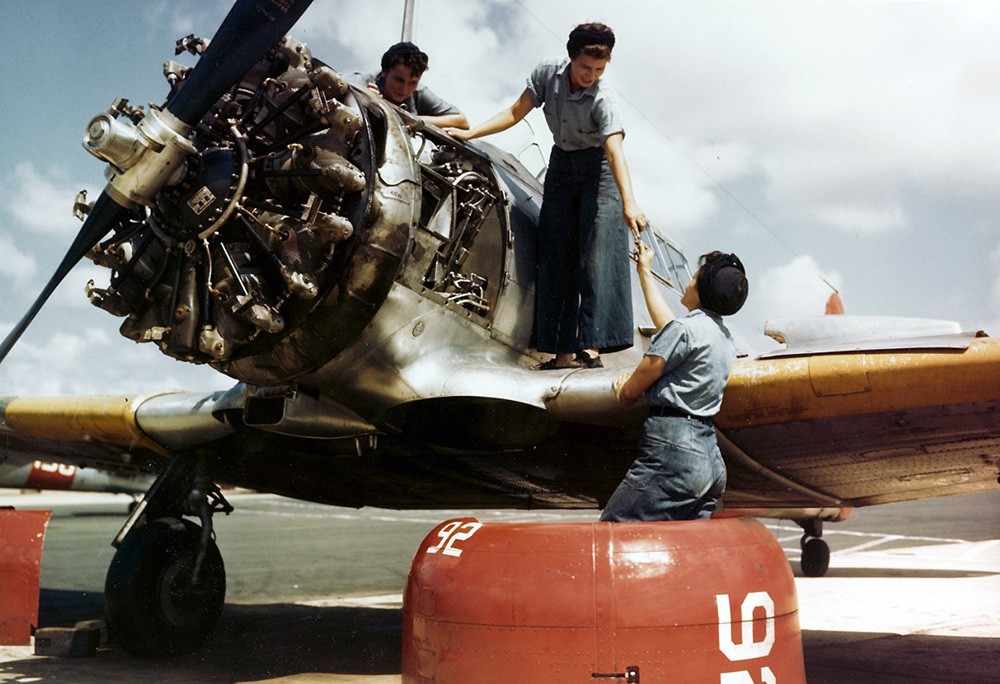
Naval Auxiliary Air Station, Whiting Field, Pensacola, Florida. WAVES aircraft mechanics working on a North American SNJ training plane, circa 1943-45. Note their dungaree uniforms. Official U.S. Navy photograph, now in the National Archives, 80-G-K-15003.
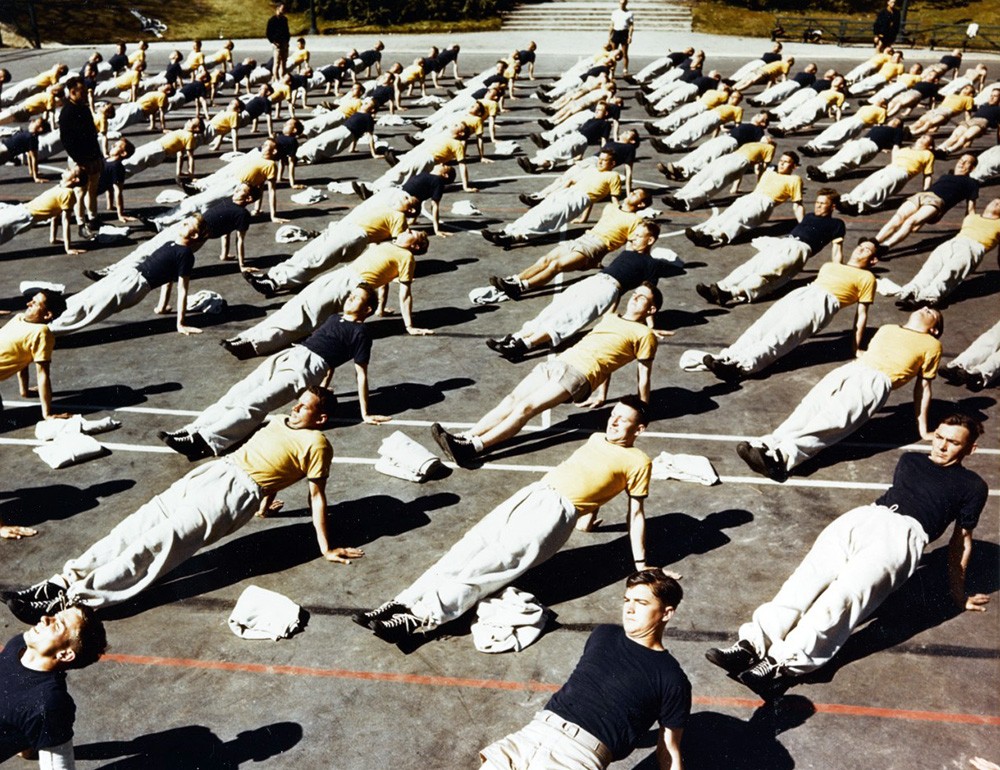
Del Monte Pre-Flight School, Monterey, California, 1942-44. Naval aviation cadets do calisthenics on the tennis court of the school, which was located at the former Del Monte hotel. Official U.S. Navy photograph, now in the collections of the National Archives, 80-G-K-15057.
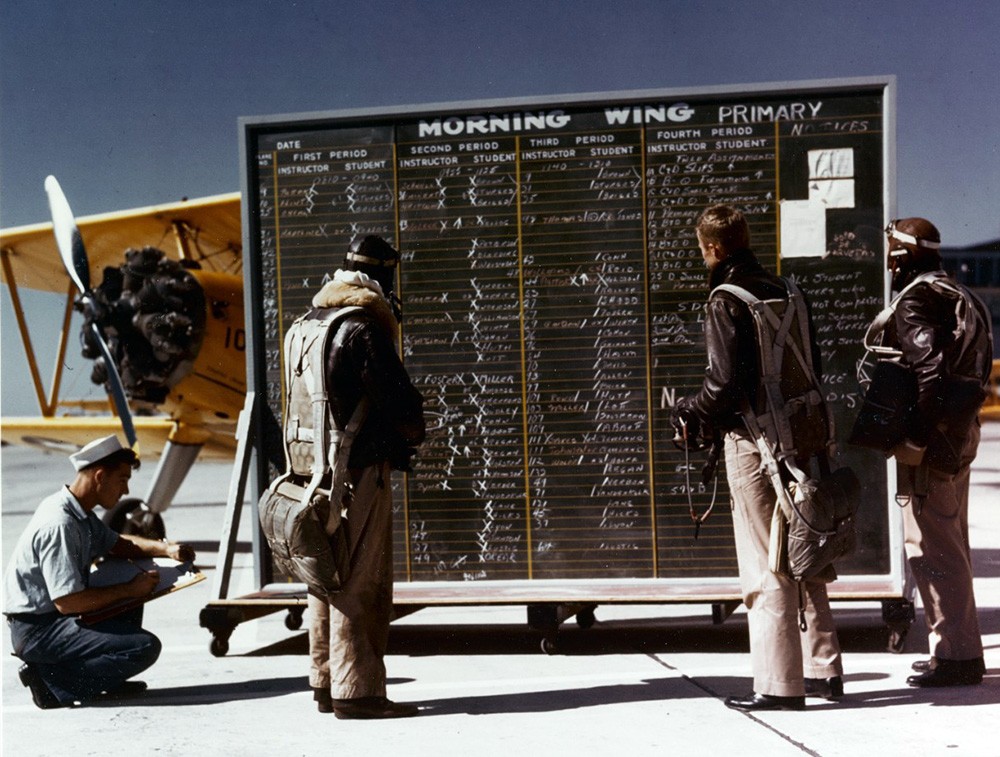
Naval aviation cadet training, circa 1942-43. Flight instructors and naval aviation cadets check the operations board for the morning flight schedule at a naval air station. Note the Stearman N2S parked behind the board. Official U.S. Navy photograph, now in the collections of the National Archives, 80-G-K-15048.
Fighting Flattops
The success of naval aviation soon provided the opportunity for the photographers to follow the new pilots to combat assignments on aircraft carriers. These huge ships, known as “fighting flattops,” were each home to 3,000 men. Horace Bristol, who had worked for Life and Fortune magazines before the war, was the first to go to sea. He was on board USS Santee (CVE-29) off North Africa in 1942 to photograph Operation Torch, the first Allied amphibious landing of the war. Charles Kerlee and Dwight Long, the unit’s motion picture specialist, were shipmates on USS Yorktown (CV-10) as she headed for the Pacific in 1943. Wayne Miller joined USS Saratoga (CV-3) and flew on missions with Air Group 12.
Meanwhile, Edward Steichen, now age 64, was notified by the Navy that he had reached retirement age and was being removed from active duty. He appealed the decision and fortunately received word that he could continue his present duties. He quickly arranged for a tour of duty on USS Lexington (CV-16) with Victor Jorgensen. Some of the best-known images of the war come from his tour on this carrier.
Steichen never gave his men detailed shooting scripts but encouraged them to use their instincts. His prime directive was “Don’t photograph the war, photograph the man, the little guy; the struggle, the heartaches, plus the dreams of this guy. Photograph the Sailor.”
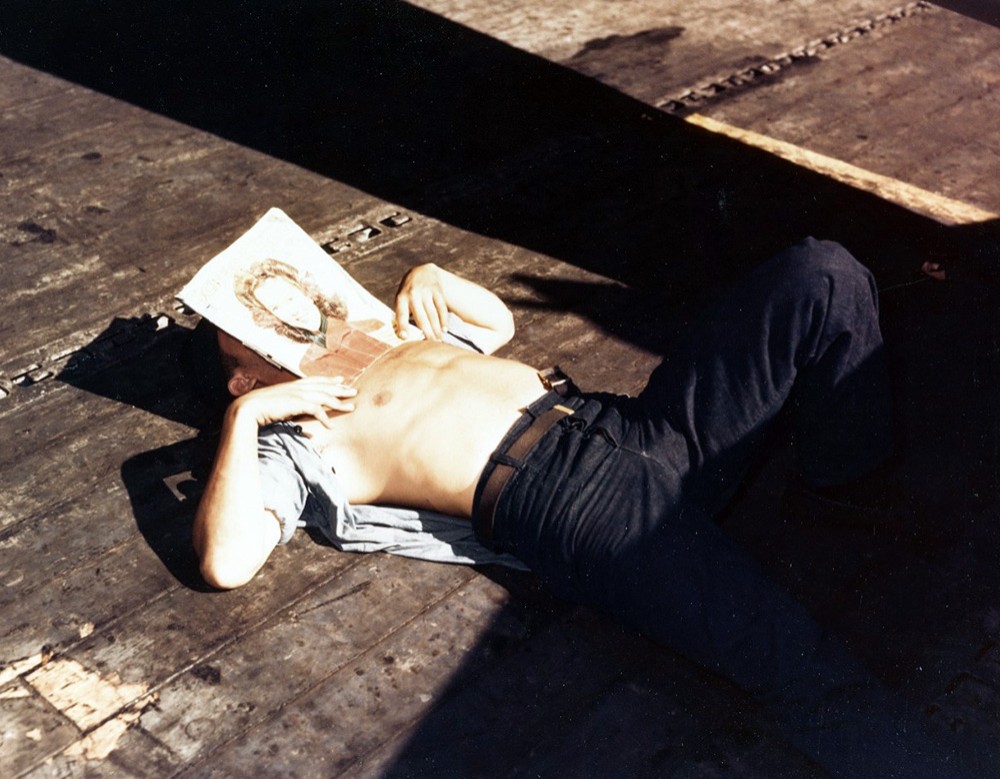
USS Lexington (CV-16), November 1943. Flight deck crewman catches a quick nap and a bit of sun during a lull in operations, taken during the Gilberts campaign. Photographed by Edward Steichen. Official U.S. Navy photograph, now in the collections of the National Archives, 80-G-K-15351.
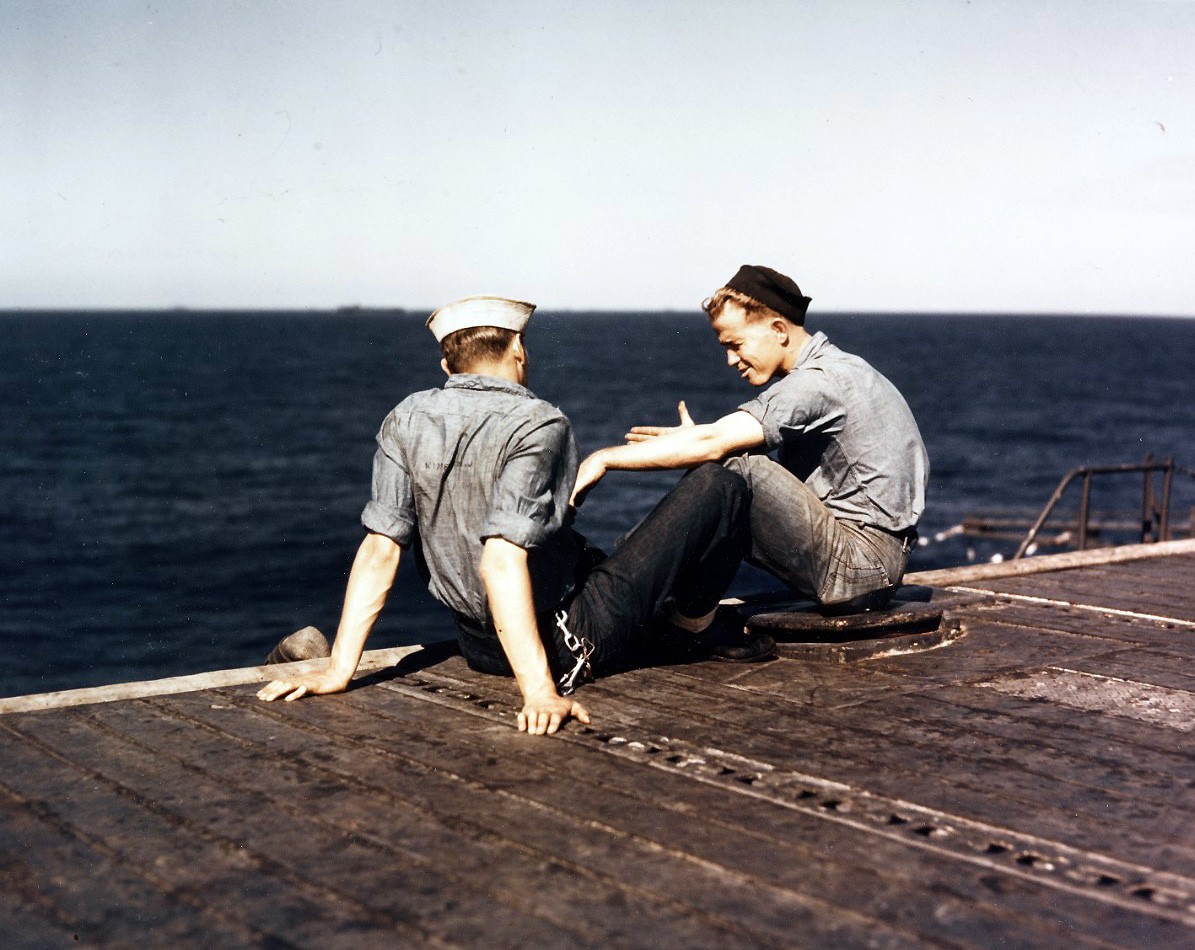
USS Lexington (CV-16), November-December 1943. Two crewmen relax on the flight deck during a lull in operations. Man at right is sitting on an arresting cable. Photographed by Edward Steichen. Official U.S. Navy photograph, now in the collections of the National Archives, 80-G-K-15558.
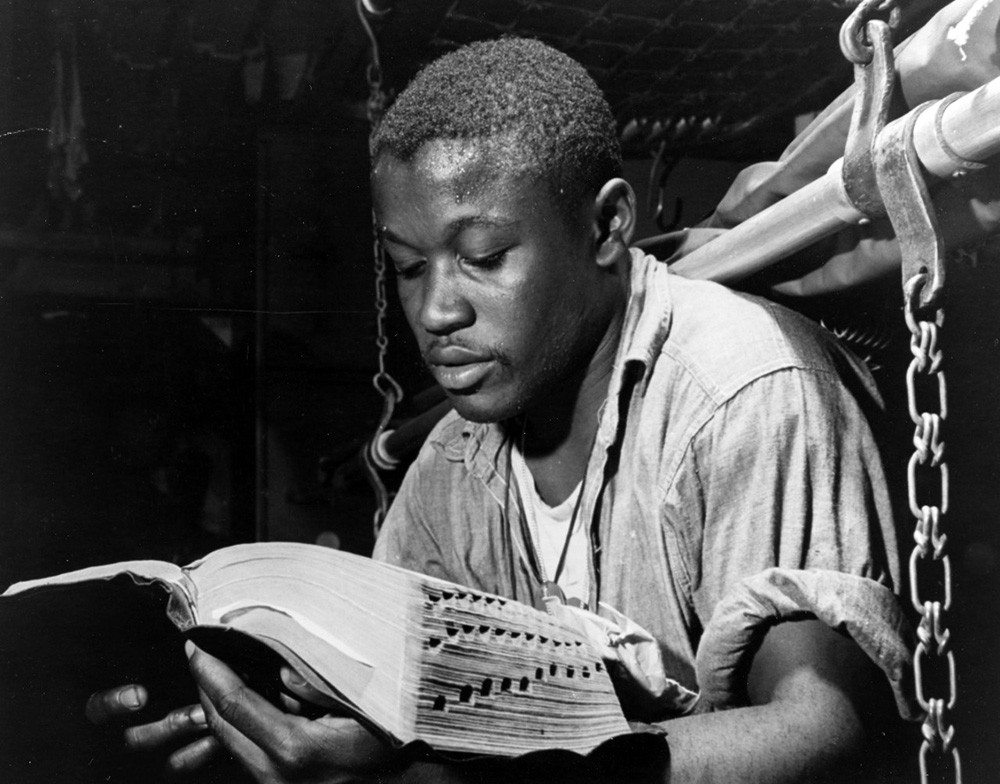
Steward’s Mate Second Class James L. Frazer, January 1945, takes time to read a few chapters from his Bible, part of his daily devotional routine while serving on board an aircraft carrier. He was photographed the night before his ship launched strikes on the Manila Bay area in support of the Lingayen Gulf landing operations. Photographed by Edward Steichen’s photographic unit. Official U.S. Navy photograph, now in the collections of the National Archives, 80-G-305241.
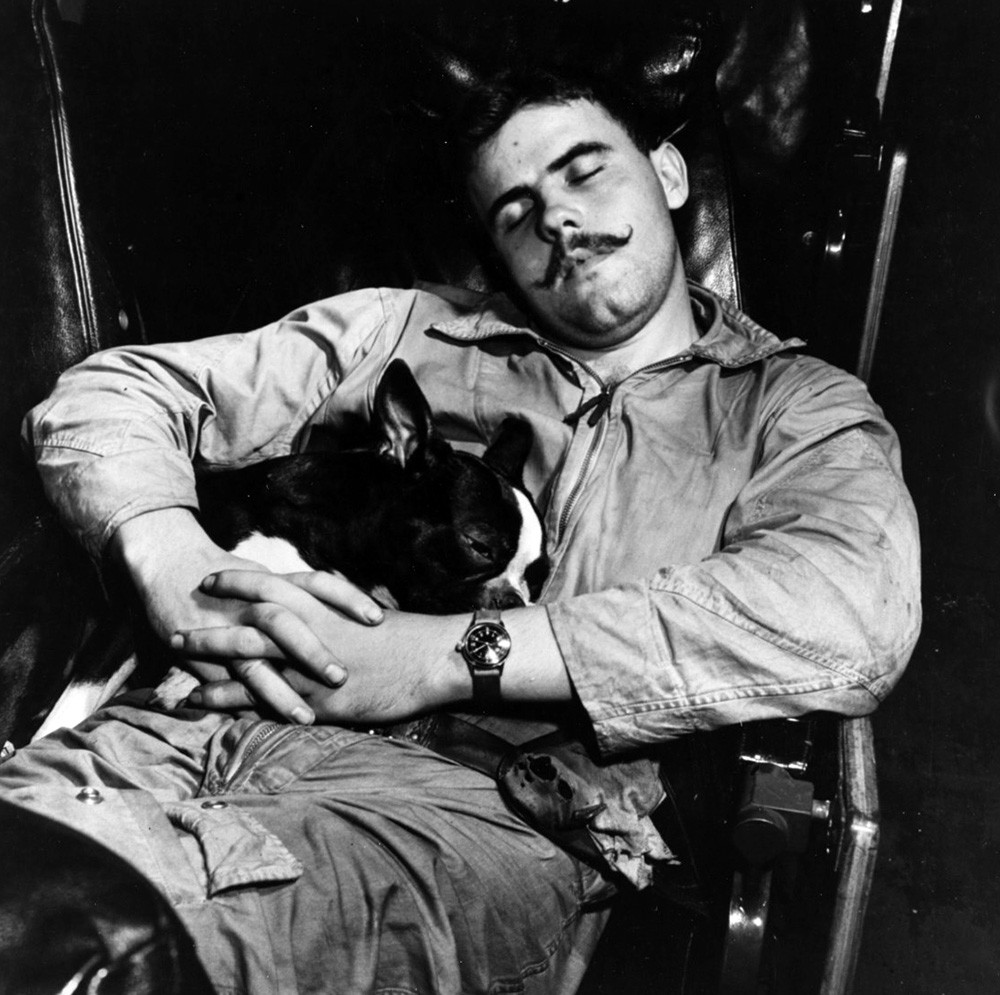
Lieutenant (j.g.) H. Blake Moranville, USNR. Napping in Fighter Squadron 11’s ready room on USS Hornet (CV-12) in company with VF-11’s macot dog, circa January 1945. He was shot down while strafing Saigon airport, French Indochina, on January 12, 1945. Captured by local French authorities, he ultimately escaped to China. Photographed by Lieutenant Commander Charles Kerlee, USNR. Official U.S. Navy photograph, now in the collections of the National Archives, 80-G-469326.
Between the Battles
Waiting is a large part of war. Navy men spent long hours at sea or stationed on remote islands waiting to meet the enemy. And everyone was a long way from home.
Steichen’s men followed the sailors and pilots during these lonesome times. They traveled on carriers, on submarines, on battleships, and to shore stations around the world. This freedom of movement was possible because Steichen had insisted that all his photographers were commissioned as officers. This status, plus open orders, allowed them to go where they wanted, recording what war looked like from the average sailor’s point of view. Steichen urged his men to move in and shoot close up and to seek out the one image that distilled a whole story.
The photographers returned their exposed film for processing to the Washington lab where Steichen inspected the photos and specified how the images should be cropped and printed for release. Early in the war, Steichen had established the special lab to provide the professional technical backup he knew was necessary. Steichen also worked closely with Dwight Long, whose motion picture unit produced the documentary The Fighting Lady, showing everyday life on the carrier Lexington.
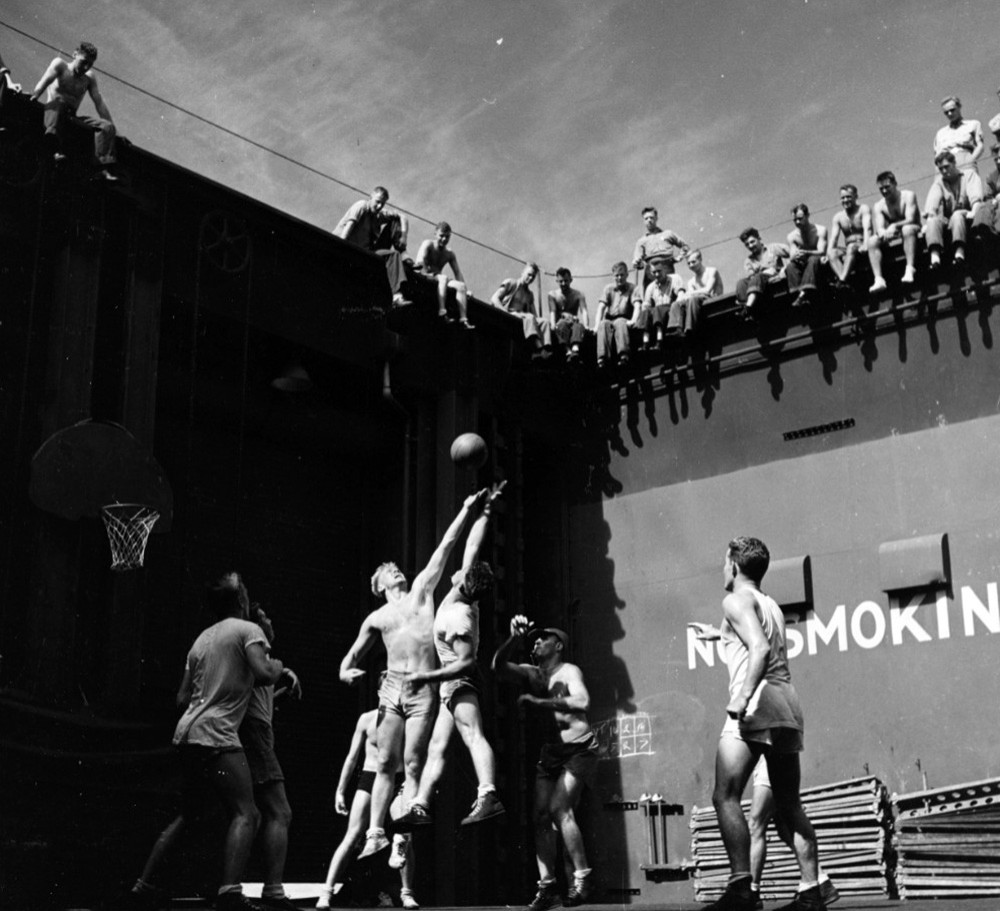
USS Monterey (CVL-26). A game of basketball in the forward elevator during operations in the Marianas, June-July 1944. Player at left jumping for ball is Lieutenant Gerald Ford, future President of the United States. Photographed by Victor Jorgensen. Official U.S. Navy photograph, now in the collections of the National Archives, 80-G-417628.
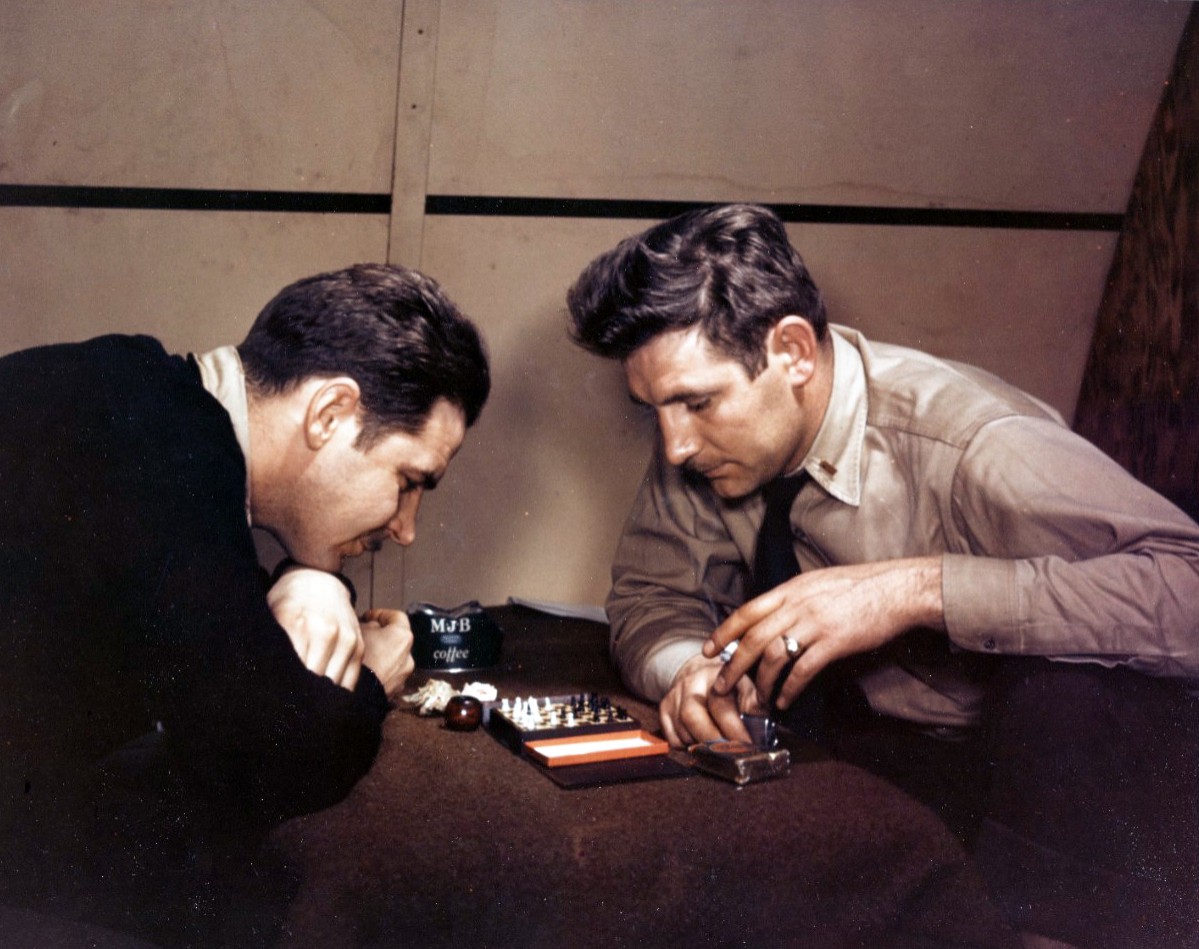
A chess game occupies the time of two Navy pilots in their quarters at an Aleutian advanced base, circa 1942-43. Note the pack of Lucky Strike cigarettes and coffee-can ashtray. Photographed by Horace Bristol. Official U.S. Navy photograph, now in the collections of the National Archives, 80-G-K-15429.
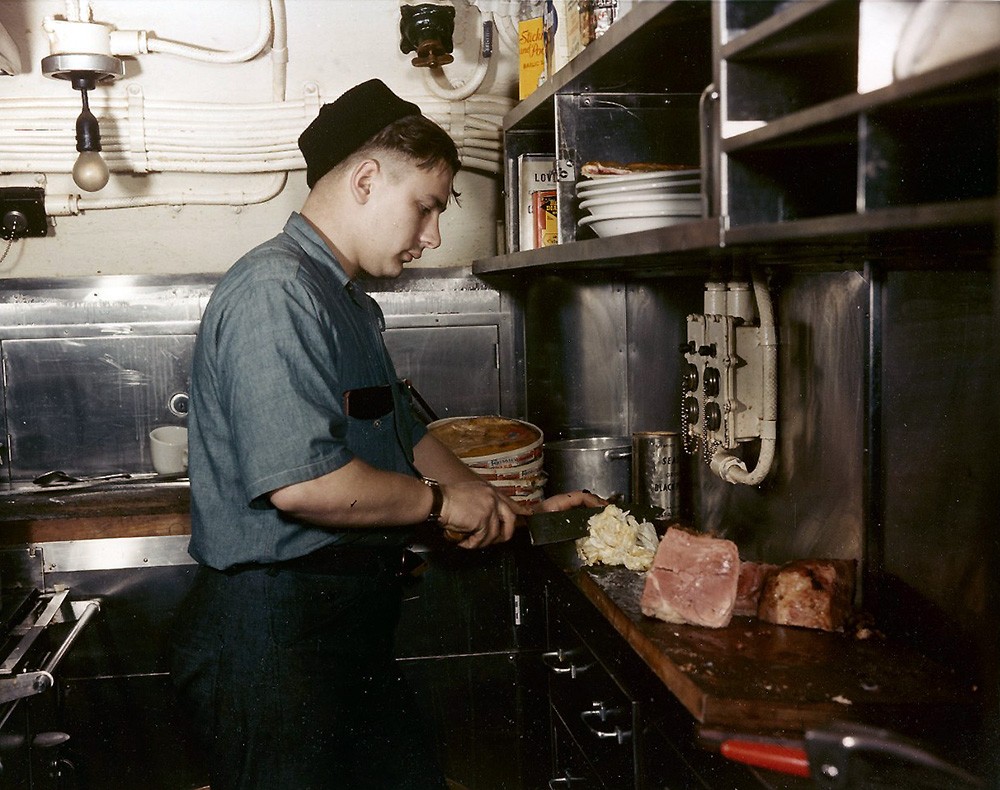
Submarine galley scene. Cook cutting lettuce, probably for ham sandwiches, in the galley of a U.S. Navy submarine during World War II. Photographed by Edward Steichen. Official U.S. Navy photograph, now in the collections of the National Archives, 80-G-K-13535.
Advance Across the Pacific
By 1944, the United States had begun to ascend the long chain of islands that led directly to Japan. The amphibious invasion of these islands resulted in some of the most savage fighting in the war. Although air strikes and naval bombardments could begin a week before the actual landings, the U.S. Marines and soldiers who made the landings found a well-dug-in and determined enemy. Casualties were extremely high on both sides.
Several new photographers joined Steichen’s unit in 1944. Among them was Marine Corps Sergeant Paul Dorsey, who had been a news photographer before enlisting . In February 1945, 30,000 Marines landed on the beaches of Iwo Jima, only 700 miles from Tokyo. It was the bloodiest battle in the history of the Marine Corps. In five weeks of fighting, more than 6,000 Marines died before the island was secured.
As the war entered its final six months, Steichen was promoted to captain and named director of the Navy’s newly created Naval Photographic Institute. He was now responsible for all the Navy’s combat photographers.
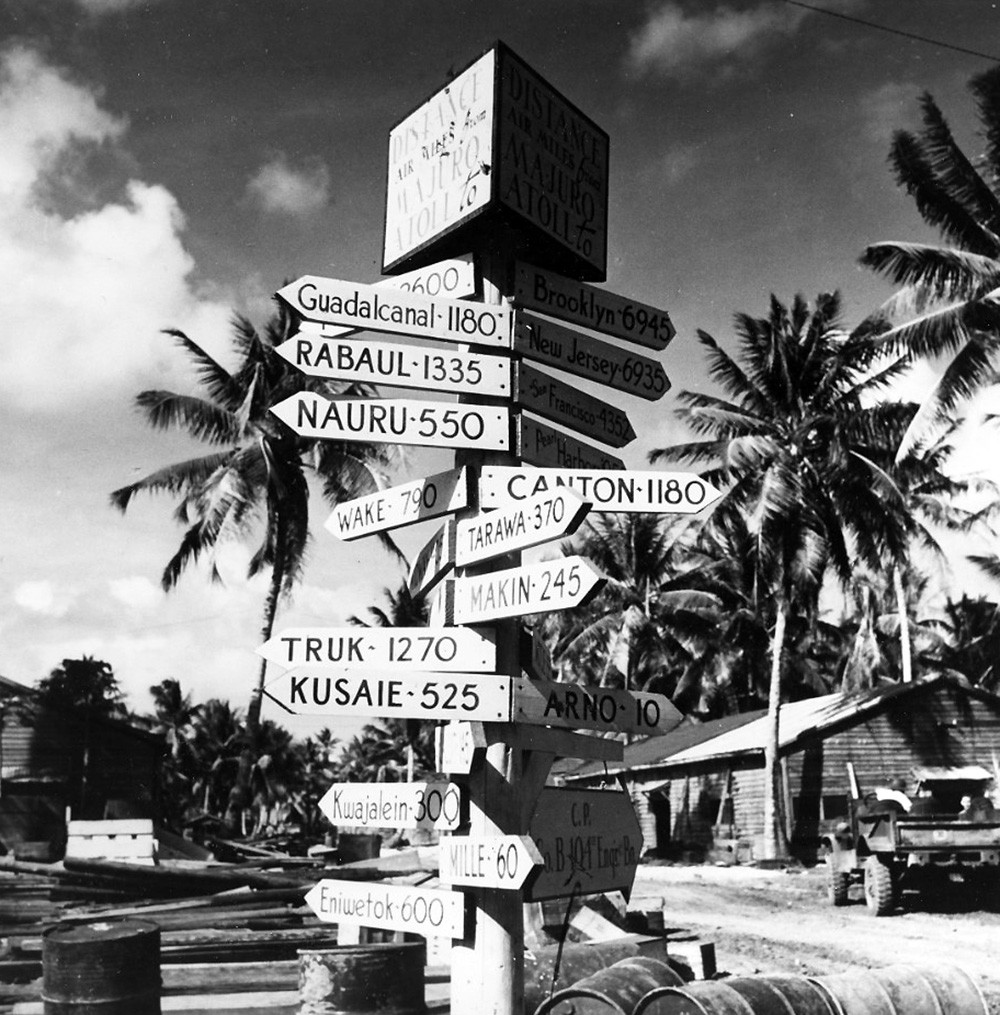
Signpost on Majuro: The men stationed on remote islands often made signposts to show new locations and how far they were from home. Photographed by Lieutenant Commander Charles Kerlee, USNR, March 1944. Official U.S. Navy photograph, now in the collections of the National Archives: 80-G-401008.
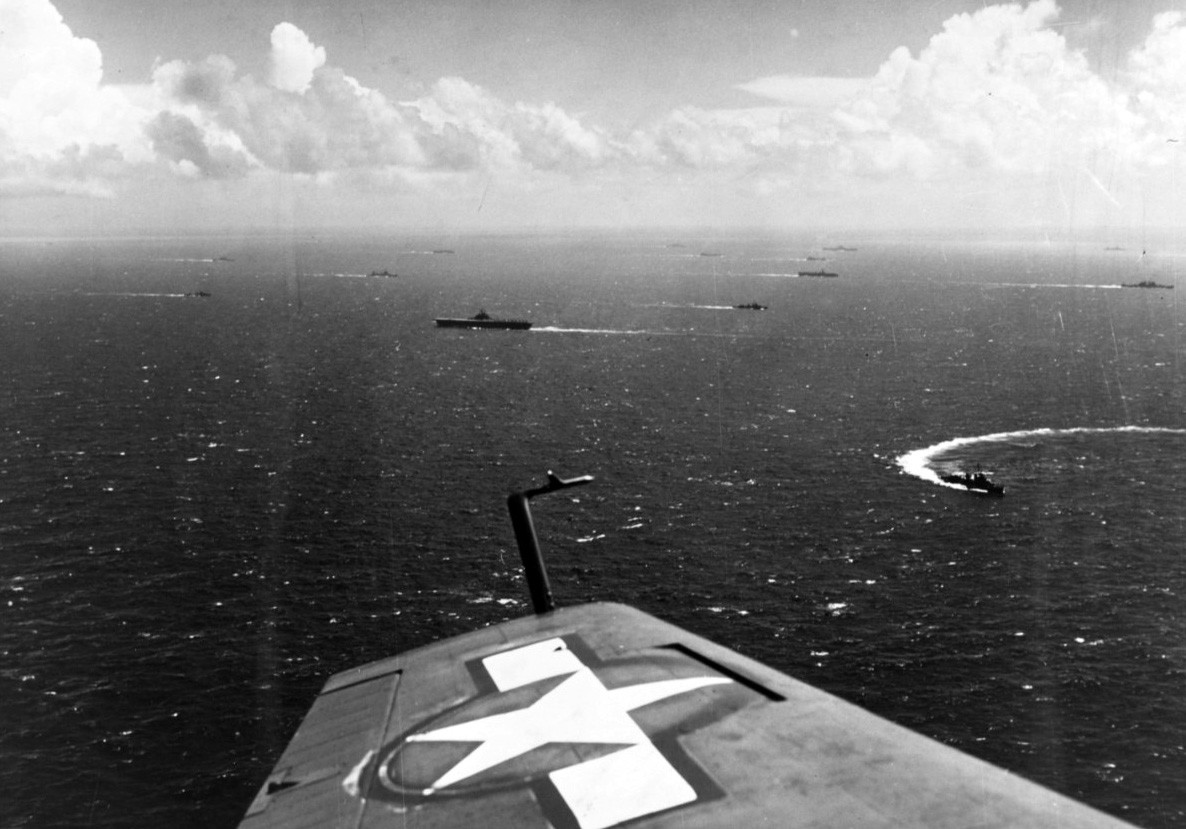
Wake Island raid. Carriers, destroyers, and cruisers of the Pacific Fleet en route to raid Wake Island, circa early October 1943. Official U.S. Navy photograph, now in the collections of the National Archives: 80-G-472529.
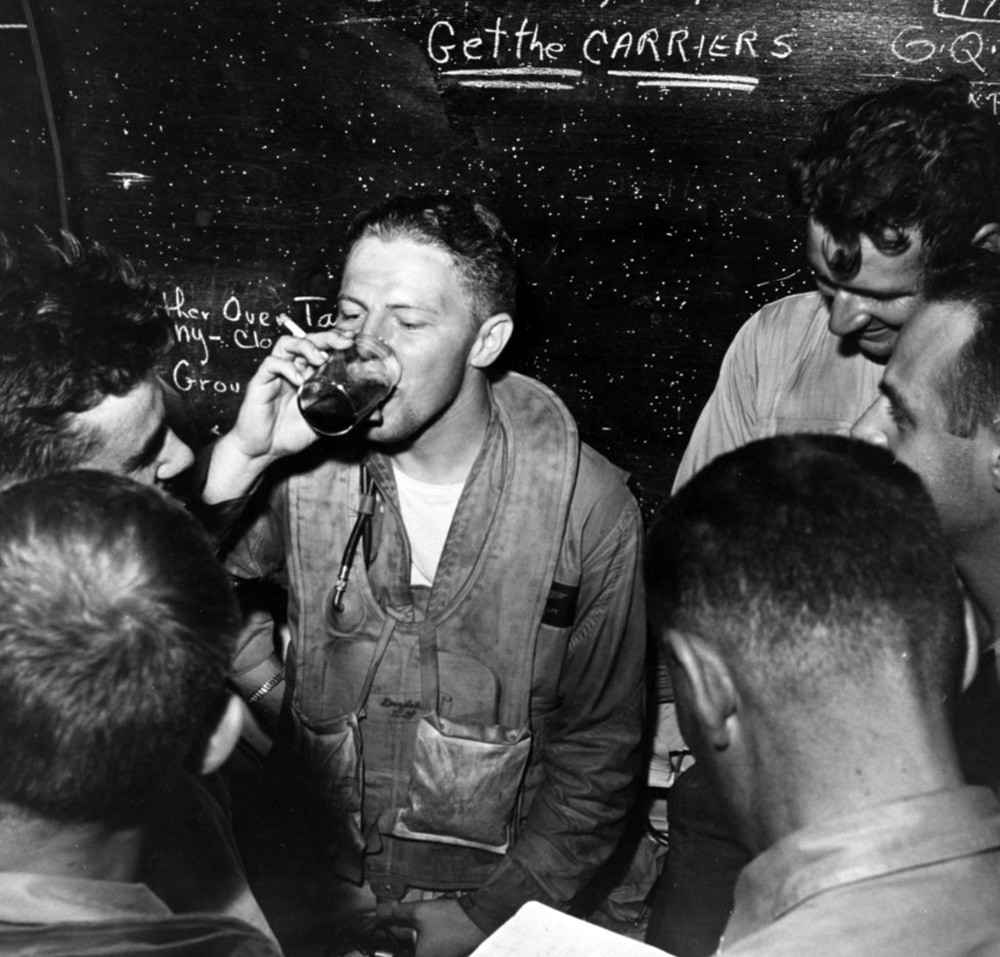
Battle of the Philippine Sea. Lieutenant Ronald P. “Rip” Gift relaxes with other pilots in a ready room on board USS Monterey (CVL-26) after landing on the ship at night following strikes on the Japanese fleet, June 20, 1944. Photographed by Lieutenant Victor Jorgensen. Official U.S. Navy Photograph, now in the collections of the National Archives: 80-G-44791.
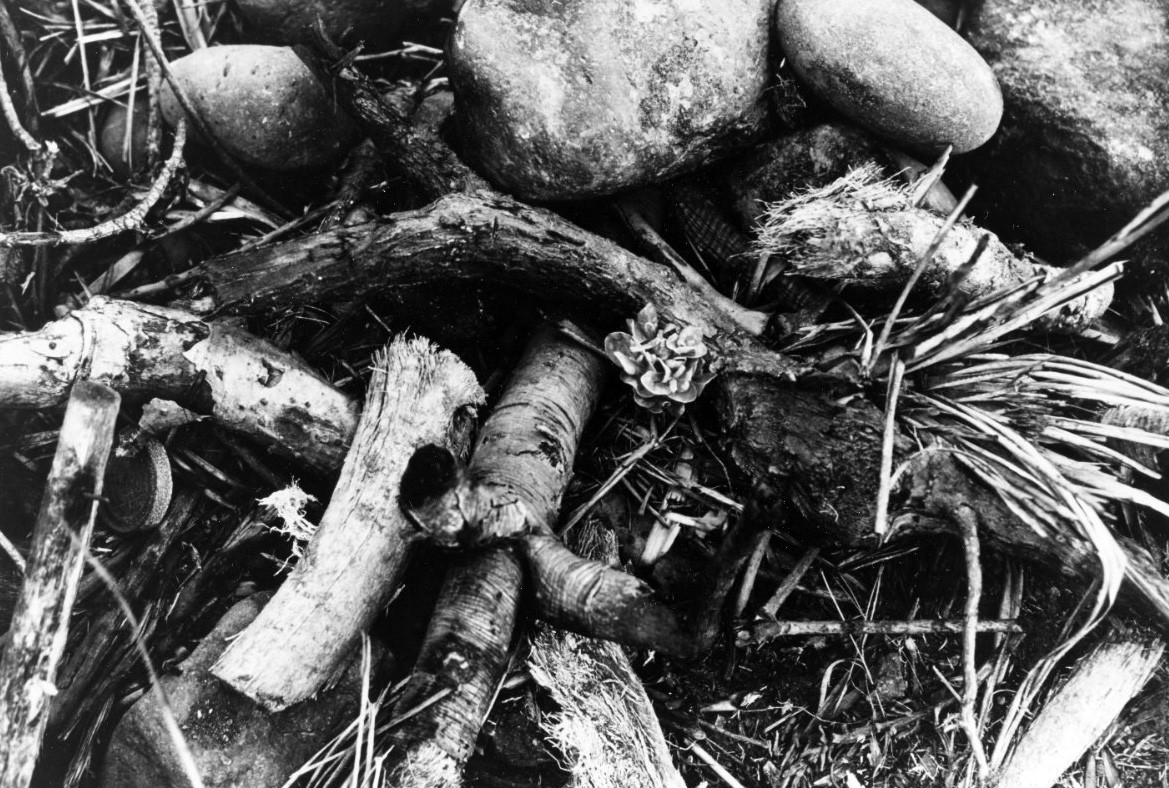
Battle of Iwo Jima, 1945. A small flower, the only living thing in sight, pokes through a mass of uprooted rocks and mangled tree branches on a desolate hillside of Iwo Jima. Photographed by Captain Edward Steichen. Official U.S. Navy Photograph, now in the collections of the National Archives: 80-G-412461.
“In the Navy, I started with a handful of good photographers who became experts, not only in using a lens, but in photographing with their hearts and minds. The influence of that handful spread to 4,000 Navy photographers.”
Edward Steichen
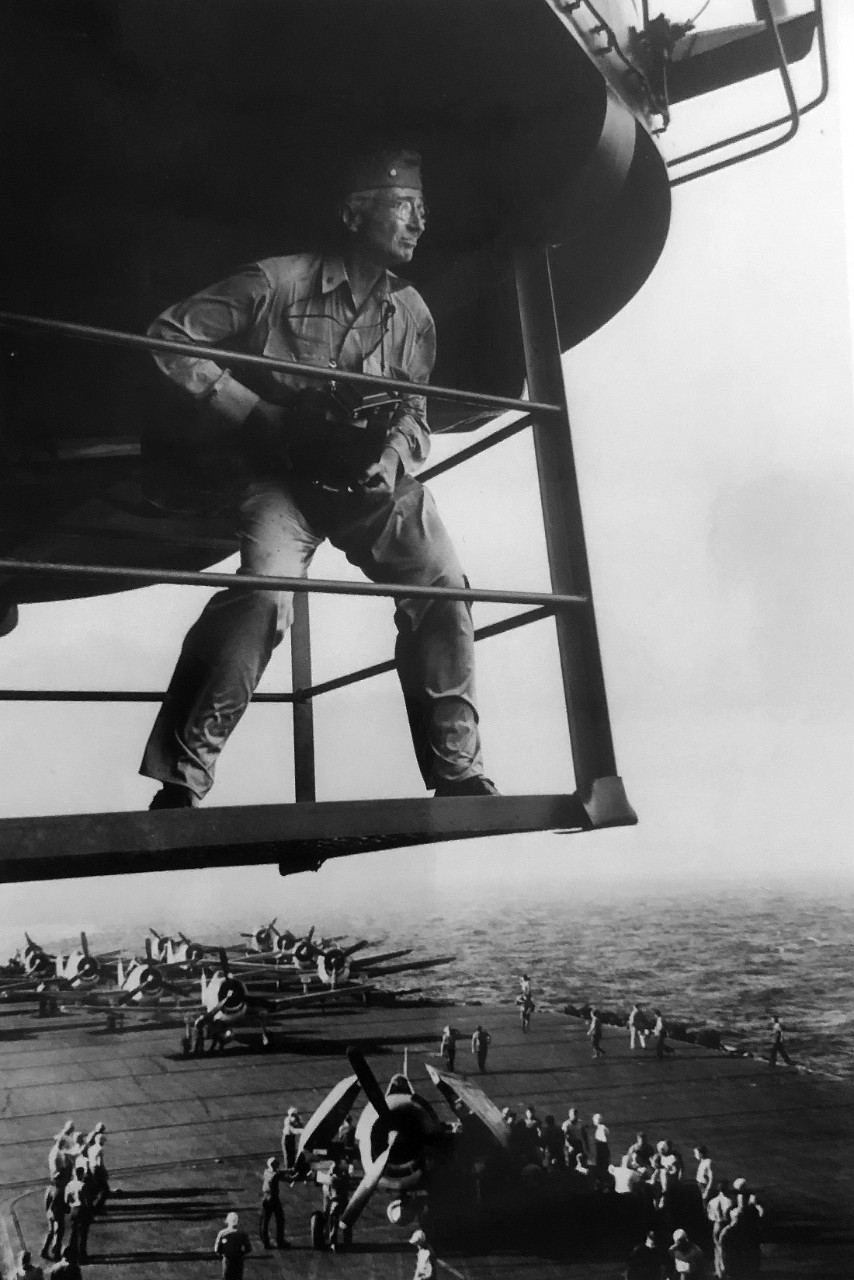
Commander Edward Steichen on USS Lexington (CV-16) with planes on deck below. Composite photograph released on June 16, 1945. Official U.S. Navy photograph, now in the collections of the National Archives, 80-G-324556.
Edward Steichen
Born in Luxembourg on March 27, 1879, Edward Steichen immigrated with his family to Michigan in 1881 and relocated to Milwaukee, Wisconsin, eight years later. After apprenticing at a lithograph company and winning local awards, he had his first photographic exhibit in 1899 at Philadelphia. A meeting with world-renowned photographer Alfred Stieglitz in New York led to collaboration on Stieglitz's Camera Work magazine. Subsequently, Steichen lived and worked in Paris, France, where his studio was based in the city's Latin Quarter. In Paris, he explored canvas art and creative photography. After the start of World War I, he returned to New York, volunteered for the U.S. Army, was commissioned a first lieutenant, and established the first photographic reconnaissance division for the Signal Corps. While in the Army, he established a permanent division of aviation photography.
As of 1922, Steichen focused only on photography and became the chief photographer for Condé Nast publications, where his photographs appeared in Vogue and Vanity Fair. Six years later, his book, Steichen: The Photographer, was published. For the next ten years, exhibitions of his work were held at the Museum of Modern Art and the Baltimore Museum of Art.
In 1942, Steichen was commissioned a lieutenant commander in the U.S. Naval Reserve. At the age of 62, he led the Navy’s new Naval Aviation Photographic Unit. In November and December 1943, he served aboard USS Lexington (CV-16) during the Gilbert and Marshall Islands operation, where he supervised the film The Fighting Lady. In 1945, Steichen was named director of the new U.S. Navy Photographic Institute and was placed in charge of all naval photography by Secretary of the Navy James Forrestal.
Released from active duty with the rank of captain, Steichen compiled the book U.S. Navy War Photographs: Pearl Harbor to Tokyo Harbor. While director of the Department of Photography of the Museum of Modern Art (MOMA) in New York, he finalized the publication The Blue Ghost, a photographic account of his time on board Lexington. During the Korean War, Steichen resumed his naval career to evaluate and make recommendations regarding Navy photography. In 1961, the Steichen the Photographer exhibit opened at MOMA in honor of his 82nd birthday. On December 6, 1963, President Johnson awarded him the Presidential Medal of Freedom. Retiring to his farm in Connecticut, Steichen died on March 25, 1973, two days before his 94th birthday.
Following its tenure at the Navy Museum, the Steichen exhibit went on tour at various Smithsonian-affiliated museums until 1992.
